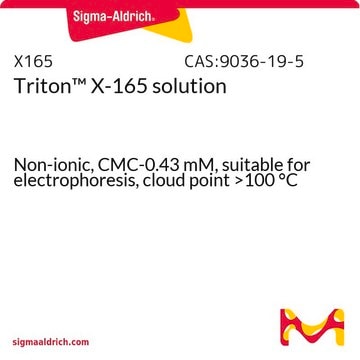About This Item
Produtos recomendados
descrição
non-ionic
Nível de qualidade
peso molecular
757 g/mol
CMC
0.33 mM
temperatura de transição
cloud point 88 °C
HLB
14.4
InChI
1S/C18H30O3/c1-17(2,3)14-18(4,5)15-6-8-16(9-7-15)21-13-12-20-11-10-19/h6-9,19H,10-14H2,1-5H3
chave InChI
LBCZOTMMGHGTPH-UHFFFAOYSA-N
Categorias relacionadas
Aplicação
- Effect of nonionic surfactants on the solubilization of alachlor.: This study explores the use of Triton X-102 in enhancing the solubility of alachlor, a widely used herbicide, demonstrating its potential to improve the environmental behavior and efficacy of agricultural chemicals (Xiarchos & Doulia, 2006).
- Enantioselectivity of structurally modified poly(sodium undecenoyl-L-leucinate) by insertion of Triton X-102 surfactant molecules.: Investigates the modification of chiral separation media with Triton X-102, enhancing enantioselective capabilities in electrophoresis applications, critical for the pharmaceutical industry (Tarus et al., 2004).
- Purification and characterization of human leukotriene C4 synthase.: Demonstrates the use of Triton X-102 in the purification processes of key enzymes involved in inflammatory responses, aiding in the development of anti-inflammatory drugs (Penrose et al., 1992).
- Partial purification and characterization of erythropoietin receptors from erythroid progenitor cells.: Utilizes Triton X-102 to isolate and study erythropoietin receptors, contributing to better understanding and treatment of anemias (Im et al., 1990).
- Isolation and characterization of insulin receptors from rat kidney glomeruli and tubules.: Explores the role of Triton X-102 in isolating specific receptors, enhancing knowledge on kidney function and potential targets for diabetes treatment (Im et al., 1988).
Informações legais
Triton is a trademark of The Dow Chemical Company or an affiliated company of Dow
Palavra indicadora
Danger
Frases de perigo
Declarações de precaução
Classificações de perigo
Acute Tox. 4 Oral - Aquatic Acute 1 - Aquatic Chronic 1 - Eye Dam. 1 - Skin Irrit. 2
Código de classe de armazenamento
10 - Combustible liquids
Classe de risco de água (WGK)
WGK 3
Ponto de fulgor (°F)
Not applicable
Ponto de fulgor (°C)
Not applicable
Equipamento de proteção individual
Eyeshields, Faceshields, Gloves, type ABEK (EN14387) respirator filter
Choose from one of the most recent versions:
Já possui este produto?
Encontre a documentação dos produtos que você adquiriu recentemente na biblioteca de documentos.
Os clientes também visualizaram
Colin E Moore et al.
ChemSusChem, 10(17), 3512-3519 (2017-07-01)
Bimetallic Sn-Pb catalysts with five different Sn/Pb atomic ratios were electrodeposited on Teflonated carbon paper and non-Teflonated carbon cloth using both fluoroborate- and oxide-containing deposition media to produce catalysts for the electrochemical reduction of CO
Pil Seok Chae et al.
Molecular bioSystems, 9(4), 626-629 (2013-02-05)
Membrane protein manipulation is a challenging task owing to limited tertiary and quaternary structural stability once the protein has been removed from a lipid bilayer. Such instability can be overcome by embedding membrane proteins in detergent micelles formed from amphiphiles
Haozhen Ren et al.
Liver international : official journal of the International Association for the Study of the Liver, 33(3), 448-458 (2013-01-11)
Hepatic tissue engineering is considered as a possible alternative to liver transplantation for end-stage liver disease. Several methods of decellularization of xenogeneic liver are available to produce three-dimensional organ scaffolds for engineering liver tissues. However, rare studies have examined and
Hirokazu Yokoyama et al.
Langmuir : the ACS journal of surfaces and colloids, 29(3), 857-860 (2012-12-29)
In this report, we present a novel approach for the elucidation of the physicochemical properties of lipid membranes by isothermal titration calorimetry (ITC) to quantify the heat absorbed during the solubilization of vesicles into TritonX-100 micelles. By using large and
Palanivelu Sengottaiyan et al.
The FEBS journal, 280(3), 965-975 (2012-12-12)
The Saccharomyces cerevisiae high-affinity phosphate transporter Pho89 is a member of the inorganic phosphate (Pi) transporter (PiT) family, and shares significant homology with the type III Na(+)/Pi symporters, hPit1 and hPit2. Currently, detailed biochemical and biophysical analyses of Pho89 to
Nossa equipe de cientistas tem experiência em todas as áreas de pesquisa, incluindo Life Sciences, ciência de materiais, síntese química, cromatografia, química analítica e muitas outras.
Entre em contato com a assistência técnica







